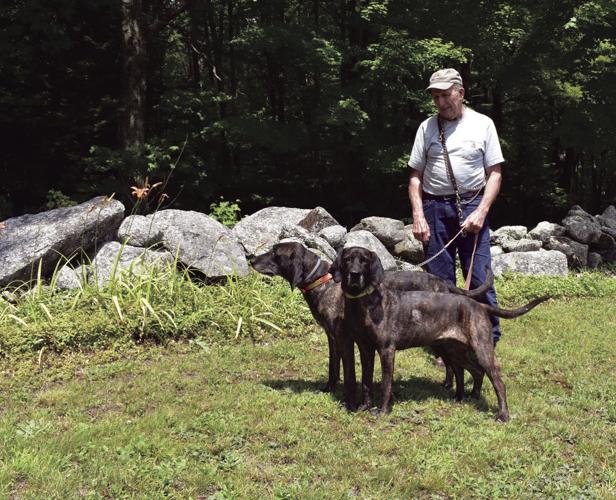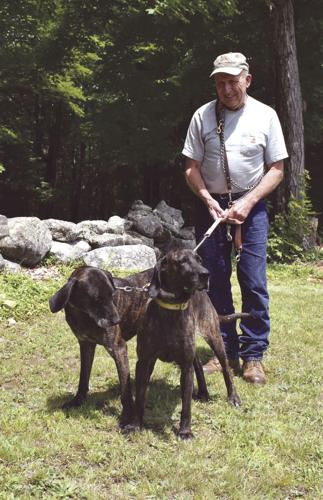GILMANTON — Sportsmen and their dogs took to the woods to train for the upcoming bear season earlier than in past years. Dan Dockham of Gilmanton said the new rule that moved up the start of bear dog training from July 15 to July 1 is really about dealing with nuisance bears.
A licensed nuisance control operator, Dockham both hunts and traps animals, and maintains that it is all part of good wildlife management.
New Hampshire Fish and Game Department wildlife biologist Andrew Timmons agrees that bear dog training serves to reduce conflicts between bruins and homeowners.
“The benefit of the training season is it helps with handling conflict,” Timmons said. “The dogs chase bears away from residences, and keep them on their toes.”
A bear can become a nuisance when it discovers cultivated berries, free-range chickens, or uncovered feed barrels. Dockham said education is a big part of dealing with the problem. Fish and Game will show farmers how to install electric fencing to deter predators, even supplying a fence on a free trial.
When those measures do not work — or are not utilized — the nuisance complaints come in.
Bear season does not begin until Sept. 1, but taking dogs out for training allows them to learn to run and tree the bears. That sends a message that the bear might be better off elsewhere.
Timmons said his department supports the earlier starting date for bear dog training, but does not favor training earlier than July. Vermont allows bear dog training to start on June 1.
“There’s been a push to open it much earlier, but we have preferred not to start until July 1 so it gives the cubs a chance to get to size. But also, June is a lean time for food. We view it as one of the toughest months for bears, and didn’t want to add any undue stress on these animals at that time. In July, food is more abundant and they can develop body fat, so this minimizes any stress or impact during that time in June.”
The New Hampshire Fish and Game Department places other restrictions on bear dogs. They must be licensed for training, and a separate permit is necessary to actually participate in a hunt. Timmons said that, in any given year, the department may issue 140 licenses, but some of those are non-dog-owners who want to go out with someone who has dogs.
“On an average year, 325 people obtain a permit to take a bear with dogs, most of which are not people who own dogs,” he said. “The overall harvest by hunters using dogs is low and the smallest percentage (12%) of the harvest methods.”
There also are restrictions on how many dogs can be used — no more than six dogs on a chase and, while dogs may be swapped out, Fish and Game advises huntsmen to not rerun bears — that is, treeing a bear and then pursuing it again when the bear comes down.
“If properly done, there’s minimum impact,” Timmons said.
The training involves teaching the dogs to pursue only the bear while ignoring other animals. They can run and tree bears, but the huntsman cannot shoot the bear during the pre-season training period.
“We also recommend not running them in the heat of the day,” Timmons noted. “And if the bear is hot, the dogs are hot.”
Other restrictions include a prohibition on the use of telemetry.
Controversial
Linda Dionne, president of the New Hampshire Animal Rights League, opposes bear hunting and said, “Hounding is not fair-chase hunting. It gives the hunter an unfair advantage.”
In an email response to questions from The Laconia Daily Sun, Dionne said, “The dogs are the athlete, not the hunter, who simply has to follow the radio frequency emitted by the dogs’ collars.”
She continued, “[Fish and Game] recommends not killing females with cubs [but] by the time the hunter catches up to the dogs and the cornered bear, there are no cubs to be seen. 494 female bears were killed by bear hunters last year. That is a historical high. Also at an historical high was the number of orphaned cubs. Can’t just be a coincidence or all blamed on lack of food. Orphaned cubs, without the guidance of adults, may become problems in residential areas as was seen in Manchester last year shortly after bear hunting season began.”
“We recognize that it’s controversial,” Timmons said, “but the harvest is low.”
Over the last two or three decades, there have been a number of proposed legislative bills to prohibit the use of dogs, or to stop bear hunting completely, but Timmons said there have been very few changes in the law since the original statute became law in 1935.
“It’s been pretty varied in other states,” Timmons said. “Maine has a similar season, Massachusetts doesn’t allow hounds, and New York does not allow hounds to take a bear, but they do have a training season.”
Seventeen states allow the taking of bear with hounds, with 13 of them allowing the training of dogs outside the “take” season. Four states allow the training of dogs but prohibit the taking of bear.
The sport is much more prevalent in the southern states, from Virginia and West Virginia south.
“It’s less prevalent in the north, but that’s a function of history and tradition,” Timmons said.
Hunters from other states are allowed to do so in New Hampshire only if they have a reciprocity agreement, allowing New Hampshire residents to hunt there. In New England, Maine is the only state offering reciprocity.
Bear hunting with the use of dogs is especially popular in the Sandwich and Tamworth areas, and Tamworth police recently put out a bulletin to warn residents that bear dog training is underway.
Food or fur
Dockham noted that he is one generation away from living totally off the land. His father was from a large family and had a farm where he grew his own food, as well as hunting for meat. He instilled his code of killing an animal only for food or for its fur. Dan Dockham took the lesson to heart.
“My wife doesn’t like bear meat, so I don’t kill them,” he said. In more than 50 years of hunting, he has killed only two bears, the first for the novelty of it, and the second because the bear was killing livestock.
“I like to get out in the woods,” he said. “For me, my family comes first, but going out hunting is better than drinking, getting in trouble, or chasing women.”
Growing up, he said, there was always a dog in the house, and a friend raised beagles for rabbit hunting. Dockham’s first hunt was for raccoons.
Before rabies decimated the raccoon population, farmers used to want to get rid of raccoons raiding their corn crops. They were so prevalent, Dockham said, “We could go out at night, tree a coon, and be home before midnight.”
He got into bear hunting through his friend, Bruce Cairns, a hunting guide from Randolph who teaches how to be selective in killing bears.
“I consider myself pretty good at determining the bear’s sex, but my partner wouldn’t let anyone shoot a female bear. He keeps a diary and, last year, all his clients shot were males.”
Dockham maintains that shooting a bear can be the best option for the beasts. “Otherwise, nature takes over, and they die from tooth-and-claw or from starvation.”
The dogs
Dockham hunts with Plott hounds, one of the top breeds for bear-hunting and the only one not derived from fox hounds. They were bred in North Carolina and are honored as the state dog.
The training involves teaching them to ignore other animals and focus on the bear, and on cornering or treeing the bear without attacking it.
“If you don’t have a bear dog, you find someone who does,” Dockham said, so the dog in training learns how it’s done.
Some dogs still will go after everything — earning the term “trashy dogs.” To break them from going after squirrels, coyotes, or deer, hunters generally use training collars that deliver a shock to deter them. “It doesn’t really hurt them, but they get the idea,” Dockham said.
To teach the dog to follow a scent, a hunter can buy trapping lures to drag along and create a scent trail.
As for treeing a bear, Dockham said that is a trait that is inbred in the hounds they have today.
“We can’t train them not to nip at the bear, but we can breed them not to,” Dockham said. “A good tree dog will stay there for hours,” giving the hunter time to catch up.
To find a bear, Dockham will go to a place with berries or other bear habitat, and the dogs will get the bear’s scent.
He typically starts about 5 a.m. in order to be out of the woods by 8 or 9, before the heat of the day.
Dionne points out that avoiding running the dogs on hot days is only a recommendation, “which makes it legal. Not to mention the bears who are put at risk also of heat stroke or exhaustion.”
She also said that a cornered bear may attack, putting dogs at risk of injury.
Dockham said he has never had a dog who was badly hurt, and certainly not a life-threatening injury. There are other hazards of running in the woods, and one of his hounds, Ellie, is recovering from a wound from a sharp tree branch.
Dionne said dogs also are at risk of getting diseases from ticks.
Dockham still maintains that hunting with the dogs he loves is worth the risk, and that being selective and making a clean kill is better than other fates for bears.
“I love all wildlife, and bears,” Dockham said. “We need common sense in all of this.”



















(0) comments
Welcome to the discussion.
Log In
Keep it Clean. Please avoid obscene, vulgar, lewd, racist or sexually-oriented language.
PLEASE TURN OFF YOUR CAPS LOCK.
Don't Threaten. Threats of harming another person will not be tolerated.
Be Truthful. Don't knowingly lie about anyone or anything.
Be Nice. No racism, sexism or any sort of -ism that is degrading to another person.
Be Proactive. Use the 'Report' link on each comment to let us know of abusive posts.
Share with Us. We'd love to hear eyewitness accounts, the history behind an article.